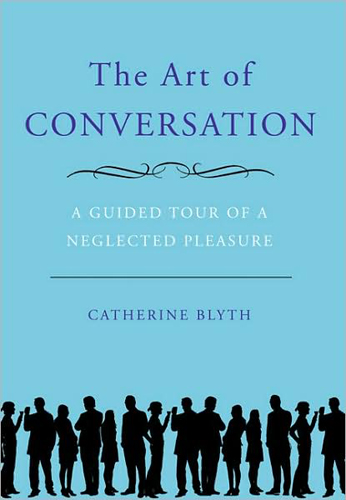Author Catherine Blyth knows a present day truth: our ever expanding use of electronic devices for communication, which have us buried in our phones and laptops without even making eye contact with those around us, is causing a loss of in-person communications skills. Connecting to other humans has always fulfilled a basic human need, and she wrote The Art of Conversation: A Guided Tour of a Neglected Pleasure with the intent to bring this connection and the joys we get from it back into our lives.
Blyth begins by showing how conversation is not only a pleasure, but an important vehicle for understanding and developing human relationships. She explains the many ways that modern life has become bad for conversation and outlines aspects of high quality communication. Each chapter addresses an element of conversation, such as how to begin a discussion or the purpose of small talk. She goes outside the obvious and also addresses how to pay attention during an interaction, deal with less than skilled conversationalists, and even the power of silence. Toward the end of the book, Blyth lays out more advanced skills of conversation, gives advice on how to navigate difficult conversations and even how to wage a word war.
Each chapter has its own set of rules, which Blyth uses to reinforce the theme of the chapter. The rules are a good way to organize the chapter and its ideas, and there are lots of them; I counted a total of ninety-seven!
Reading The Art of Conversation motivated me to assess my own conversation skills, including recognizing when I fail to listen as intently as I should, and to be more at ease with quiet moments and the power it can contain. Blyth has a chapter titled, “How to Tell a Lie” with the subheading “On the Detection of Untruths.” This title/subtitle combination is an example how the book plays with the topics, and the surprising ways she introduces her lessons. In the case of identifying a lie (by knowing how to tell one) such a skill is certainly useful as we are often naive, or untrained in lie detection, and wish for the ability to avoid being fooled. Wish no more, it’s in this book! She also has an interesting chapter on flattery. Readers learn how being more adept at adulation can bring happiness into the lives of others, and transform the world into a happier place.
While The Art of Conversation addresses the subject broadly with interesting tangents and orbiting ideas around the main topic, it can be hard to read. Catherine herself admits that writing about conversation can be like chasing butterflies. While butterfly chasing is pleasant, trying to read streams of thought as random as the flight of butterflies can be mentally taxing. As a result, I enjoyed reading this book in small doses at a time.
Its weaknesses don’t negate the usefulness and good to be found in The Art of Conversation, which I recommend to all those who genuinely care about their ability to communicate with others and who will enjoy a unique, less academic, approach to the topic. However, this is a book to keep on your nightstand (or in your bathroom) to be read in small increments, and gradually your ability to masterfully converse in person will certainly grow.
~by LiveTrue Book reviewer, Melanie Davis

